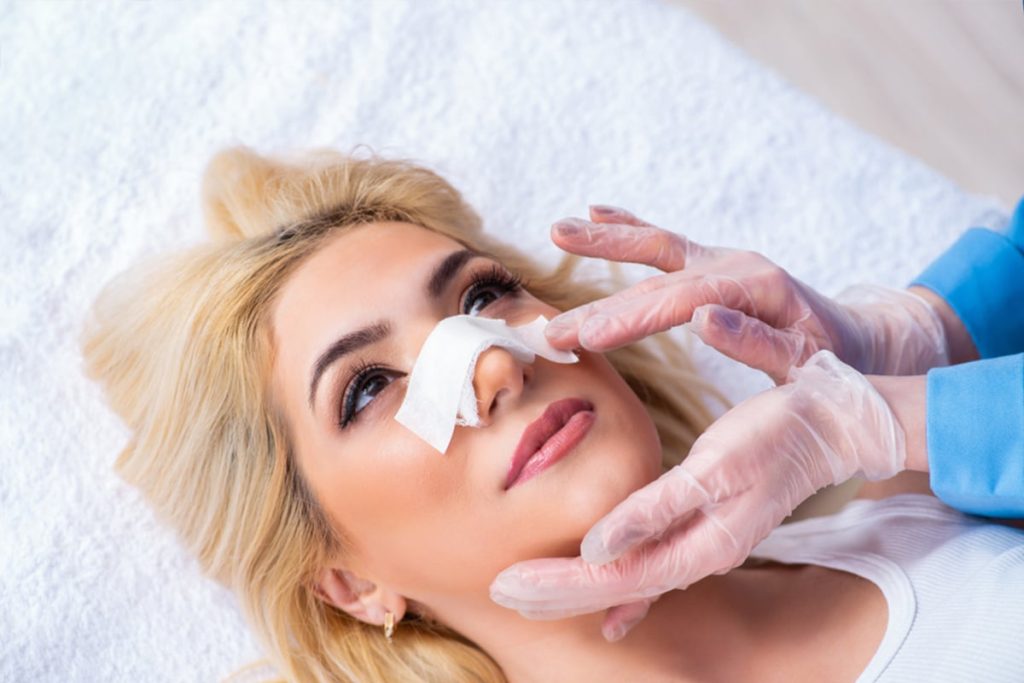Did you know that the average rhinoplasty recovery time for nose surgery or nasal surgery is about one to two weeks for a healing nose and swollen nose? This timeline can vary based on individual factors, but understanding what to expect during your rhinoplasty recovery journey can make a world of difference. Whether you’re considering rhinoplasty surgery for cosmetic reasons or to improve breathing, knowing the recovery process and asymmetrical healing helps set realistic expectations.
You’ll learn about the typical healing stages after rhinoplasty surgery, tips for a smooth recovery, and what activities to avoid following the rhinoplasty procedure. By the end, you’ll be better prepared for your journey to a new nose, understanding rhinoplasty surgery, rhinoplasty recovery timeline, and asymmetrical healing. Stick around to get all the essential details on navigating your rhinoplasty recovery with ease.
Before Rhinoplasty Basics
Discuss Expectations
Rhinoplasty patients should discuss their expectations with their surgeon. This ensures clarity and alignment of goals. The surgeon will explain what is realistically achievable. Clear communication helps avoid disappointment.
Prepare for Surgery
Before rhinoplasty surgery, compile a list of current medications and supplements. Some substances can affect healing or interact with anesthesia. Share this list with the surgeon.
Consider bringing reference photos of desired nose appearances. These photos help illustrate your goals. Visual aids can make discussions more productive.
Thorough Examination
Undergo a thorough examination before the nose job procedure. This includes measurements and photographs. These details help tailor the rhinoplasty surgery approach to your unique anatomy.
The surgeon will analyze your nasal structure. They might use digital imaging to show potential results. This step ensures a personalized plan.
During the Procedure Insights
Anesthesia Choice
Choosing the right anesthesia is crucial. General anesthesia puts you to sleep completely. Local anesthesia with sedation numbs the area and relaxes you. The choice depends on your health and the complexity of the surgical procedure. Your surgeon will discuss the best option during your consultation.
Surgery Duration
The duration of rhinoplasty varies. Most procedures last between one to three hours. Simple reshaping takes less time. More complex surgeries take longer. Discuss the expected duration with your provider before the surgery date.
Immediate Post-Operative Care
Plan for post-operative care in advance. Arrange for someone to drive you home after the surgery. You will be groggy from anesthesia. Having a person assist you on the first night is essential. They can help manage discomfort and ensure you follow post-surgery instructions.
Outpatient Procedure
Rhinoplasty is usually an outpatient procedure. This means you go home the same day. Staying overnight in a hospital is rare unless there are complications. Ensure your home is prepared for recovery before the surgery.
Managing Discomfort
Expect some discomfort after surgery. Swelling, bruising, and mild pain are common side effects. Your surgeon will prescribe pain medication to manage this. Follow their instructions closely to ease your recovery process.
Results Timeline
Results aren’t immediate. Initial swelling masks the final outcome. It can take up to a year to see the full results of your rhinoplasty. Patience is key during this period.
Follow-Up Appointments
Regular follow-up appointments are vital. Your surgeon will monitor your healing progress and address any concerns. These visits help ensure that you achieve the best possible results.
Initial Recovery Steps
Follow Instructions
The initial recovery steps are crucial. Follow post-surgery instructions closely. Surgeons often place a plastic splint on the nose. This helps maintain its new shape. Cotton gauze packing inside the nose is common too. It helps control bleeding and supports healing.
Swelling and Bruising
Swelling and bruising around the nose and eyes are normal. These effects can last several days. Swelling may peak by day three but will gradually decrease. Bruising usually fades within two weeks. Have realistic expectations for their resolution timeline.
Signs of Complications
Stay vigilant for signs of complications. Watch for excessive bleeding, severe pain, or unusual discharge. Fever might indicate an infection. Contact your surgeon immediately if any of these occur. Regular follow-up appointments with the surgeon ensure optimal healing.
Swelling Stages Explained
Immediate Swelling
Right after surgery, facial swelling is most noticeable. The first 48 hours are crucial. Ice packs can help reduce this initial swelling. Keeping your head elevated also aids in minimizing it. Bruising around the eyes is common during this time.
First Week
By the end of the first week, some swelling and bruising will start to subside. Most patients can return to work or school. However, the nose will still be swollen. Facial swelling may extend to the cheeks and under the eyes. Stitches and splints are usually removed by this point.
Two to Four Weeks
Swelling continues to decrease gradually over the next few weeks. By four weeks, a significant amount of swelling should be gone. The nose might appear larger than expected due to residual swelling. Patients should avoid strenuous activities during this period to prevent complications.
Four to Six Weeks
Mark your calendar for this milestone. Most visible swelling and bruising significantly reduce by this time. The nose starts taking on a more defined shape. However, subtle swelling may persist, especially at the tip of the nose.

Three Months
By three months post-surgery, patients will notice further reduction in swelling. The nose will look more natural and refined. Taking photographs helps track these changes over time. Comparing these photos can show progress and provide reassurance.
Six Months
At six months, nearly all swelling should have subsided. Only minor changes may still occur as the tissues continue to settle. It’s essential to follow up with your surgeon during this period for any concerns or questions.
One Year
Adjust expectations for the final shape of the nose to become apparent at one year after surgery. This is when all residual swelling typically resolves. The final result should be stable and permanent by now.
Tips for Monitoring Progress
Keeping photographic records is a useful way to monitor healing progression. Take photos at regular intervals:
-
Immediately post-surgery
-
One week
-
One month
-
Three months
-
Six months
-
One year
These photos allow you to see how much swelling has reduced over time and appreciate the gradual improvements.
Asymmetrical Healing Insight
Common Phase
Asymmetrical healing is a normal part of the recovery process. After rhinoplasty, the nose may appear uneven. This happens because different parts of the nose heal at varying rates. Swelling can affect one side more than the other.
This phase is temporary. The body needs time to adjust and heal fully.
Early Weeks
In the first few weeks post-surgery, it is common for the nose to look crooked. Swelling and bruising can cause this appearance. Patients often worry about their results during this period.
Avoid panic or concern. Most asymmetry resolves naturally as swelling decreases. Trust the process and give your body time.
Consult Surgeon
If asymmetry persists beyond the initial healing phase, consult with your surgeon. They can provide reassurance or further evaluation. Persistent asymmetry might need additional attention.
Surgeons are experienced in recognizing normal healing patterns versus complications. They will guide you on the next steps if needed.
Managing Pain Post-Procedure
Pain Levels
Pain after rhinoplasty varies. Most patients experience mild to moderate discomfort. The pain usually peaks within the first 48 hours. After this, it gradually decreases. Swelling and bruising can add to the discomfort.
Medication Use
Surgeons often prescribe pain medications. These may include over-the-counter pain relievers like acetaminophen or stronger prescriptions. Follow the surgeon’s instructions closely. Do not take more than the recommended dose.
Anesthesia Effects
Anesthesia plays a role in pain management. Local anesthesia numbs the area during surgery. General anesthesia puts you to sleep. Both types wear off after surgery, so expect some pain post-procedure.
Home Care
Prepare your home for recovery. Have ice packs ready to reduce swelling. Keep prescribed medications nearby. Rest is crucial for healing.
Communication with Surgeon
Stay in touch with your surgical team. Report any intense or unusual pain immediately. They can adjust your pain management plan if needed.
Following Instructions
Follow all post-operative care instructions. This includes taking medications on time and attending follow-up appointments. Proper care ensures better outcomes post-surgery.
Emotional Support
Recovery involves emotional challenges too. Feeling anxious or frustrated is normal. Talk to friends or family for support.
Care Tips for Faster Recovery
Follow Instructions
Adhere strictly to the surgeon’s post-operative care instructions. These guidelines are crucial for a smooth recovery. They often include activity restrictions and wound care advice. Ignoring these can lead to complications.
Surgeons usually recommend avoiding strenuous activities. This helps prevent increased blood flow to the face, reducing swelling and bruising. Proper wound care is also vital to avoid infections.
Elevate Head
Implement lifestyle adjustments like sleeping with the head elevated. This minimizes swelling and promotes better blood circulation. Use extra pillows or a wedge pillow for support.
Avoid lying flat on your back. This position can increase pressure on the nose, hindering recovery. Keeping the head elevated at all times during sleep is essential.
Avoid Strenuous Activities
Strenuous activities should be avoided for at least two weeks post-surgery. Exercise increases heart rate and blood pressure, which can cause bleeding or swelling in the nasal area.
Light activities like walking are usually safe. However, consult your surgeon before resuming any physical activity. Take it slow to ensure proper healing.
Maintain Healthy Diet
Maintain a healthy diet rich in vitamins and hydration. Nutrients like Vitamin C and Zinc play a key role in tissue repair and immune function. Fresh fruits, vegetables, lean proteins, and whole grains should be included in meals.
Drink plenty of water to stay hydrated. Proper hydration supports the body’s natural healing processes. Avoid alcohol and caffeine as they can dehydrate the body.
Skin Care
Take special care of your skin during recovery. Use gentle cleansers and moisturizers recommended by your surgeon. Avoid harsh skincare products that can irritate the surgical area.
Protect your skin from sun exposure. UV rays can damage healing tissues and cause discoloration. Wear sunscreen and hats when going outside.
Monitor Progress
Regularly monitor your progress and attend follow-up appointments with your surgeon. These visits help ensure that everything is healing properly and allow for early detection of any issues.
Resuming Daily Activities
First Week
During the first week, rest is crucial. Avoid strenuous activities. Keep your head elevated when sleeping. This helps reduce swelling and promotes healing. Avoid bending over or lifting heavy objects.
Follow your surgeon’s advice closely. They will provide specific guidelines for you. Protect your nose from any accidental bumps. It can affect the healing process.
Two Weeks Post-Surgery
By the second week, some daily activities can be reintroduced. Light walking is acceptable. Avoid intense exercise or heavy lifting. These activities can increase blood pressure and cause bleeding.
Work can be resumed if it does not involve physical strain. Face-to-face social engagements should be limited to avoid potential contact with germs.
Three to Four Weeks
At this point, more activities can be resumed. Light exercises like jogging may be allowed. Always consult your surgeon before increasing activity levels.
Sun exposure should be minimized. Use SPF on your nose to prevent discoloration or damage. The skin on your nose will be sensitive during this period.
One Month Onwards
After a month, most daily activities can be resumed. Intense exercises and sports may still need caution. Follow your surgeon’s guidance to ensure safe recovery.
By the end of the first month, swelling should have reduced significantly. The nose will start to take its final shape, but full healing might take up to a year.
Important Tips
-
Avoid smoking and alcohol as they can impede healing.
-
Maintain a healthy diet rich in vitamins.
-
Stay hydrated to help with overall recovery.
-
Keep follow-up appointments with your surgeon.
Closing Thoughts
Rhinoplasty recovery can be a rollercoaster, but with the right care, you’ll get through it smoothly. Remember, patience is key. Your body needs time to heal and reveal the final results. Stick to the guidelines provided by your surgeon.
Ready to take the next step? Follow these tips, stay positive, and soon you’ll enjoy the new you. Share your journey with others who might need encouragement. Got questions or tips of your own? Drop them in the comments below. We’re here to support you every step of the way!
Frequently Asked Questions
How long does initial recovery take after rhinoplasty?
Initial recovery typically takes 1-2 weeks. During this period, expect swelling and bruising.
When can I resume normal daily activities post-rhinoplasty?
You can usually resume light activities after 1 week. Full physical activities may take up to 4-6 weeks.
What are the common stages of swelling after rhinoplasty?
Swelling peaks at 2-3 days post-surgery and starts to diminish by the end of the first week. It can take several months for all swelling to fully subside.
How can I manage pain after rhinoplasty?
Pain is generally mild and manageable with prescribed medications. Over-the-counter pain relievers like acetaminophen can also help.
Is asymmetrical healing normal during rhinoplasty recovery?
Yes, it’s common for one side to heal faster than the other. This usually balances out over time.
What care tips help speed up rhinoplasty recovery?
Elevate your head while sleeping, avoid strenuous activities, and follow your surgeon’s care instructions diligently.
Can I wear glasses or sunglasses after rhinoplasty?
Avoid wearing glasses or sunglasses directly on your nose for at least 4-6 weeks. Use cheek supports or contact lenses if possible.





